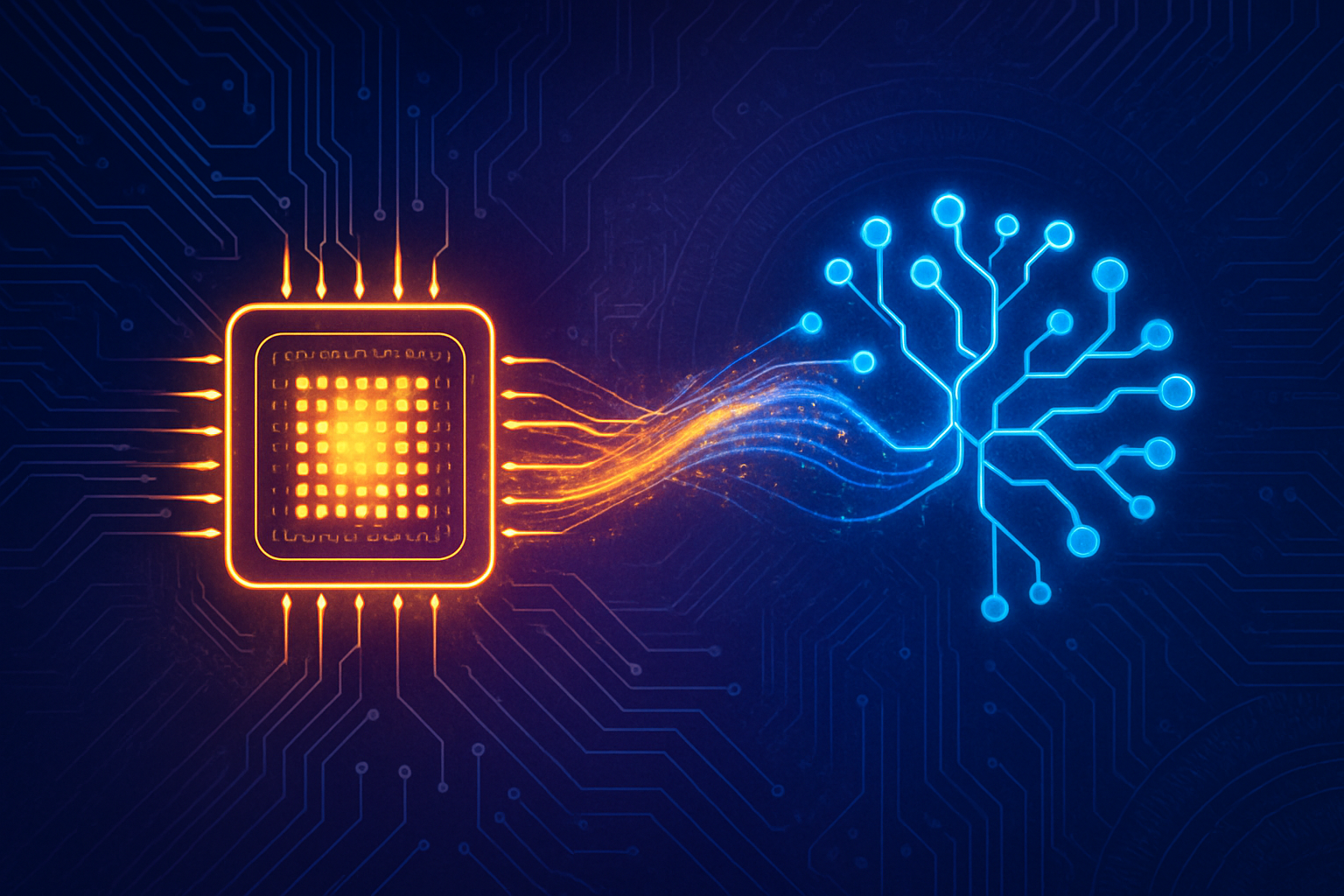San Jose, CA & San Francisco, CA – October 14, 2025 – In a move set to redefine the landscape of artificial intelligence infrastructure, semiconductor titan Broadcom Inc. (NASDAQ: AVGO) and leading AI research firm OpenAI yesterday announced a strategic multi-year partnership. This landmark collaboration will see the two companies co-develop and deploy custom AI accelerator chips, directly addressing the escalating global demand for specialized computing power required to train and deploy advanced AI models. The deal signifies a pivotal moment for OpenAI, enabling it to vertically integrate its software and hardware design, while positioning Broadcom at the forefront of bespoke AI silicon manufacturing and deployment.
The alliance is poised to accelerate the development of next-generation AI, promising unprecedented levels of efficiency and performance. By tailoring hardware specifically to the intricate demands of OpenAI's frontier models, the partnership aims to unlock new capabilities in large language models (LLMs) and other advanced AI applications, ultimately driving AI towards becoming a foundational global utility.
Engineering the Future: Custom Silicon for Frontier AI
The core of this transformative partnership lies in the co-development of highly specialized AI accelerators. OpenAI will leverage its deep understanding of AI model architectures and computational requirements to design these bespoke chips and systems. This direct input from the AI developer side ensures that the silicon is optimized precisely for the unique workloads of models like GPT-4 and beyond, a significant departure from relying solely on general-purpose GPUs. Broadcom, in turn, will be responsible for the sophisticated development, fabrication, and large-scale deployment of these custom chips. Their expertise extends to providing the critical high-speed networking infrastructure, including advanced Ethernet switches, PCIe, and optical connectivity products, essential for building the massive, cohesive supercomputers required for cutting-edge AI.
This integrated approach aims to deliver a holistic solution, optimizing every component from the silicon to the network. Reports even suggest potential involvement from SoftBank's Arm in developing a complementary CPU chip, further emphasizing the depth of this hardware customization. The ambition is immense: a massive deployment targeting 10 gigawatts of computing power. Technical innovations being explored include advanced 3D chip stacking and optical switching, techniques designed to dramatically enhance data transfer speeds and processing capabilities, thereby accelerating model training and inference. This strategy marks a clear shift from previous approaches that often adapted existing hardware to AI needs, instead opting for a ground-up design tailored for unparalleled AI performance and energy efficiency.
Initial reactions from the AI research community and industry experts, though just beginning to surface given the recency of the announcement, are largely positive. Many view this as a necessary evolution for leading AI labs to manage escalating computational costs and achieve the next generation of AI breakthroughs. The move highlights a growing trend towards vertical integration in AI, where control over the entire technology stack, from algorithms to silicon, becomes a critical competitive advantage.
Reshaping the AI Competitive Landscape
This partnership carries profound implications for AI companies, tech giants, and nascent startups alike. For OpenAI, the benefits are multi-faceted: it offers a strategic path to diversify its hardware supply chain, significantly reducing its dependence on dominant market players like Nvidia (NASDAQ: NVDA). More importantly, it promises substantial long-term cost savings and performance optimization, crucial for sustaining the astronomical computational demands of advanced AI research and deployment. By taking greater control over its hardware stack, OpenAI can potentially accelerate its research roadmap and maintain its leadership position in AI innovation.
Broadcom stands to gain immensely by cementing its role as a critical enabler of cutting-edge AI infrastructure. Securing OpenAI as a major client for custom AI silicon positions Broadcom as a formidable player in a rapidly expanding market, validating its expertise in high-performance networking and chip fabrication. This deal could serve as a blueprint for future collaborations with other AI pioneers, reinforcing Broadcom's strategic advantage in a highly competitive sector.
The competitive implications for major AI labs and tech companies are significant. This vertical integration strategy by OpenAI could compel other AI leaders, including Alphabet's Google (NASDAQ: GOOGL), Meta Platforms (NASDAQ: META), and Amazon (NASDAQ: AMZN), to double down on their own custom AI chip initiatives. Nvidia, while still a dominant force, may face increased pressure as more AI developers seek bespoke solutions to optimize their specific workloads. This could disrupt the market for off-the-shelf AI accelerators, potentially fostering a more diverse and specialized hardware ecosystem. Startups in the AI hardware space might find new opportunities or face heightened competition, depending on their ability to offer niche solutions or integrate into larger ecosystems.
A Broader Stroke on the Canvas of AI
The Broadcom-OpenAI partnership fits squarely within a broader trend in the AI landscape: the increasing necessity for custom silicon to push the boundaries of AI. As AI models grow exponentially in size and complexity, generic hardware solutions become less efficient and more costly. This collaboration underscores the industry's pivot towards specialized, energy-efficient chips designed from the ground up for AI workloads. It signifies a maturation of the AI industry, moving beyond relying solely on repurposed gaming GPUs to engineering purpose-built infrastructure.
The impacts are far-reaching. By addressing the "avalanche of demand" for AI compute, this partnership aims to make advanced AI more accessible and scalable, accelerating its integration into various industries and potentially fulfilling the vision of AI as a "global utility." However, potential concerns include the immense capital expenditure required for such large-scale custom hardware development and deployment, as well as the inherent complexity of managing a vertically integrated stack. Supply chain vulnerabilities and the challenges of manufacturing at such a scale also remain pertinent considerations.
Historically, this move can be compared to the early days of cloud computing, where tech giants began building their own custom data centers and infrastructure to gain competitive advantages. Just as specialized infrastructure enabled the internet's explosive growth, this partnership could be seen as a foundational step towards unlocking the full potential of advanced AI, marking a significant milestone in the ongoing quest for artificial general intelligence (AGI).
The Road Ahead: From Silicon to Superintelligence
Looking ahead, the partnership outlines ambitious timelines. While the official announcement was made on October 13, 2025, the two companies reportedly began their collaboration approximately 18 months prior, indicating a deep and sustained effort. Deployment of the initial custom AI accelerator racks is targeted to begin in the second half of 2026, with a full rollout across OpenAI's facilities and partner data centers expected to be completed by the end of 2029.
These future developments promise to unlock unprecedented applications and use cases. More powerful and efficient LLMs could lead to breakthroughs in scientific discovery, personalized education, advanced robotics, and hyper-realistic content generation. The enhanced computational capabilities could also accelerate research into multimodal AI, capable of understanding and generating information across various formats. However, challenges remain, particularly in scaling manufacturing to meet demand, ensuring seamless integration of complex hardware and software systems, and managing the immense power consumption of these next-generation AI supercomputers.
Experts predict that this partnership will catalyze further investments in custom AI silicon across the industry. We can expect to see more collaborations between AI developers and semiconductor manufacturers, as well as increased in-house chip design efforts by major tech companies. The race for AI supremacy will increasingly be fought not just in algorithms, but also in the underlying hardware that powers them.
A New Dawn for AI Infrastructure
In summary, the strategic partnership between Broadcom and OpenAI is a monumental development in the AI landscape. It represents a bold move towards vertical integration, where the design of AI models directly informs the architecture of the underlying silicon. This collaboration is set to address the critical bottleneck of AI compute, promising enhanced performance, greater energy efficiency, and reduced costs for OpenAI's advanced models.
This deal's significance in AI history cannot be overstated; it marks a pivotal moment where a leading AI firm takes direct ownership of its hardware destiny, supported by a semiconductor powerhouse. The long-term impact will likely reshape the competitive dynamics of the AI hardware market, accelerate the pace of AI innovation, and potentially make advanced AI capabilities more ubiquitous.
In the coming weeks and months, the industry will be closely watching for further details on the technical specifications of these custom chips, the initial performance benchmarks upon deployment, and how competitors react to this assertive move. The Broadcom-OpenAI alliance is not just a partnership; it's a blueprint for the future of AI infrastructure, promising to power the next wave of artificial intelligence breakthroughs.
This content is intended for informational purposes only and represents analysis of current AI developments.
TokenRing AI delivers enterprise-grade solutions for multi-agent AI workflow orchestration, AI-powered development tools, and seamless remote collaboration platforms.
For more information, visit https://www.tokenring.ai/.



